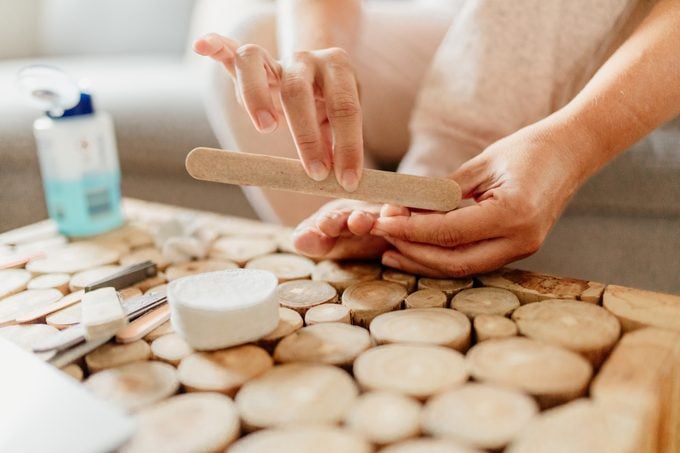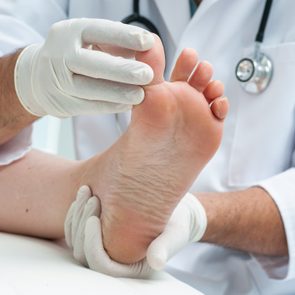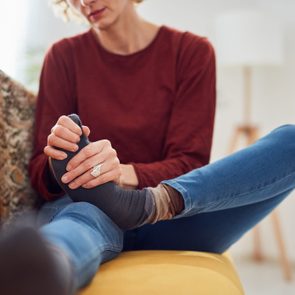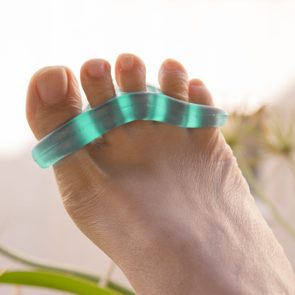Ingrown Toenails—Here’s How to Manage and Prevent Them
Updated: Apr. 12, 2021
Spare yourself the agony of an ingrown toenail with these prevention tips. And if you're already in pain, try these expert-approved home remedies.
Tender toes
Ask anyone who has had an ingrown toenail and they’ll tell you how painful they can be. It might be hard to believe that a toenail could cause so much trouble, but ingrown toenails account for 20 out of every 100 doctor visits.
The skin around the toe becomes hard, swollen, red, and tender. Wearing shoes can aggravate it even more as the toe constantly rubs against the inside of the shoe. In most incidences, you can treat and get rid of an ingrown toenail on your own. But if the pain and inflammation don’t go away, it can turn into a nasty infection.
(These are the types of toenail fungus to know.)
Here’s what you should know about ingrown toenails, including how to spot one, how to manage and prevent them at home.
How to spot an ingrown toenail
A toenail fungus is quite noticeable with yellowish nails, but you might not notice an ingrown toenail in the very early stage. A toenail trending into the skin on the side of the toenail is the first subtle sign. Next, you’ll feel pain.
“An ingrown toenail occurs when a small bit of nail at the edge pierces into the skin at the sides of the nail, causing the body to create an inflammatory reaction of redness and swelling,” says dermatologist Marcia S. Driscoll, MD, associate professor of dermatology, University of Maryland School of Medicine in Baltimore. Most often, ingrown toenails affect the big toe. It’s that piercing part that causes all the fuss and a very sore toe. Addressing the symptoms early is key.
Here’s the breakdown of the symptoms in each stage:
- Stage 1: The nail has grown and pierced into the skin on the side of the toe. The skin on the side of the ingrown toenail hurts and becomes inflamed.
- Stage 2: New inflamed tissue (called granuloma) starts growing at the edge of the ingrown toenail, which produces pus. The toenail is red and swollen and feels sore and tender to the touch.
- Stage 3: Inflammation and pus continue. Meanwhile, granuloma begins growing over the nail. The skin around the infected area is red and feels very sore.
Who gets ingrown toenails?
Anyone, at any age, can get an ingrown toenail. Even so, they tend to happen more often in teens and people over 65, says Shari Lipner, MD, a dermatologist, and director of the nail division, and professor of clinical dermatology at Weill Cornell University in New York City. Hormonal changes during puberty, along with all the excessive sweating from doing sports, raise the risks.
For some older people, taking care of feet and nails becomes a bit more challenging with aging. It’s just more difficult to reach the feet and toes, let alone trim the toenails properly. Plus, toenails get thick with age, presenting a challenge to squeeze down hard enough to clip the toenails properly. (Here are some interesting things your fingernail reveals about your body.)
What causes ingrown toenails?
When it comes to ingrown toenails, we often initiate misery by mistreating our feet and toenails. Cutting the nail too short at the side or too rounded at the edges is risky. Cramming our toes into shoes that are too narrow doesn’t do our toes any favors either. And wearing shoes with no socks isn’t a good idea either.
Other times, ingrown toenails result from doing something healthy, like running or jogging. “The activity forces the nail to come into contact with the shoe and forces the nail edge into the skin,” says Dr. Driscoll.
Obesity and conditions that cause water detention such as diabetes, kidney, and heart failure raise the risk of the toenail growing into the skin, too. There’s one other reason, that is no fault of our own. “Sometimes a person can be born with or develop a curved nail or “pincer nail,” which is a nail shaped like an upside-down “U” that curves into the skin a the sides of the toes,” says Dr. Driscoll. (If you have diabetes, you need an annual diabetic foot exam.)

How to treat an ingrown toenail at home
It’s baffling how such a tiny portion of a toenail can create a magnitude of misery. Once you have one, you want to be rid of it as quickly as possible. Unfortunately, it won’t go away overnight. But there are plenty of things you can do so it doesn’t hurt so bad to walk or wear shoes.
Fair warning—a good dose of patience and consistency is key to success. “It can take a little time for that nail to lift,” says Dr. Driscoll. Depending on the severity, you may be able to loosen the nail and get relief in a few days, or it may take a couple of weeks.
You can try one or all of the following suggestions from Dr. Driscoll to treat an ingrown toenail:
Soak your toes
Soak your toes in warm soapy water three times per day for one to two weeks. While it is soaking, gently try to pull the nail edge away from the skin. Soaking provides relief from swelling and soreness and helps the nail break away and digging into your skin. Dry the foot thoroughly, and let the toe be a toe without the pressure of shoes or socks for a while.
Separate the nail
Place a small wisp of dry cotton, dental floss, or tape to separate the nail at the edge of the skin. This encourages the nail to grow above the skin. Remove the cotton, floss, or tape daily. You can do this as a stand-alone method or try immediately after that soothing soak.
Reduce redness and pain
Apply antiseptic or anti-inflammatory gel, cream, or tincture to reduce redness and pain. (Find out the reasons why you may have toe pain.)
Tips for soothing relief
Ingrown toenails hurt and can be miserable to live with unless you can stay at home with your toe in a foot bath. Try some of these tips to get some soothing relief.
- Bandage your toe. Remember to change the bandage daily or if it gets dirty.
- Use a breathable toe protector, like ZenToes ($11, 6-pack).
- Choose the most comfortable shoes and socks you have.
- Wear open-toe shoes or sandals when you can to relieve pressure on the toe.
- Comfy slippers might be safer than going barefoot or just wearing socks while at home to prevent more pain from stubbing your toe.
- Take over-the-counter pain relievers to ease the pain.
When to see a doctor
Chances are, you won’t have to see the doctor if you start treating the toenail as soon as you notice it. But if at any time the side edge of the toe becomes red, warm, oozes pus, or you still have unrelenting pain, give your doctor or dermatologist a call. Serious complications aren’t likely to happen since the pain is annoyingly hard to live with and will head to the doctor.
Still, if an infected toenail is left untreated, it can lead to unpleasant consequences such as foot ulcers, open ores, tissue decay and death at the site of infection, and blood flow loss to the infected area.
It’s important to mention that people with diabetes or those with a weakened immune system should alert their doctor right away. They are more susceptible to wider spread inflammation or bacteria entering the nail-pierced skin.
How doctors treat ingrown toenails
“It’s important to see a board-certified dermatologist will examine the toenail, perform a wound culture and drain and/or give you a prescription antibiotic,” says Dr. Lipner. In some cases, a podiatrist may do an office procedure known as a partial nail avulsion may be necessary to decrease the width of the toenail at the offending border to relieve pain and pressure. Typically you can return to normal activities in a few days. But that’s something you should discuss with your doctor before the procedure.
Prevention tips for ingrown toenails
It turns out there are some simple ways to avoid the agony of an ingrown toenail. Here are Dr. Driscoll’s and Dr. Lipner’s recommendations:
Trim your nails properly
The primary preventative is trimming your nails properly. Cutting the sides of your toenails on an angle to round out the edges may look prettier, but it sets the scene for an ingrown toenail to happen. Instead, cut the nails straight across and not too short.
Avoid poorly-fitted shoes
Don’t wear tight-fitting footwear. It causes the side of the nail to press into the skin. Try not to wear pointy and high heel shoes for the same reason. A wide toe box allows toes to breathe and move more freely.
Avoid excess sweating
Wear breathable shoes to avoid excessive sweating. Moisture softens the skin around the toenail, making it easier for the nail to pierce the skin.
Next, find out if toe separators can help with foot pain.






















